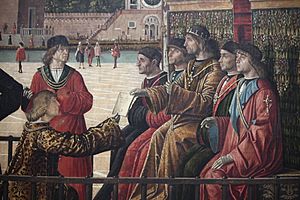Dionotus facts for kids
Dionotus was a legendary king from Cornwall, a region in southwest England. He appears in an old book called Historia regum Britanniae (History of the Kings of Britain), written by Geoffrey of Monmouth. This book tells stories about early British rulers, but many historians debate if these stories are true.
Dionotus became king after his brother, Caradocus. He acted as a temporary ruler, or "regent," for Britain. This happened while Emperor Magnus Maximus was away fighting battles in Gaul (which is modern-day France). It's interesting that other old Welsh stories don't mention Dionotus by name. Geoffrey of Monmouth might have used a Latin version of a Welsh name, possibly referring to someone like Dynod, a duke of Cornwall.
Contents
The Story of the Women of Britain
Dionotus is first mentioned when he was king under Emperor Maximus. A king named Conan Meriadoc from Brittany (a region in France) asked Britain for women. He wanted them to help his country grow and have more people.
A Journey Across the Sea
Dionotus, who was described as very noble and powerful, agreed to help. He sent a huge group of seventy-two thousand women to Gaul. However, their journey was very difficult. The ships got lost at sea. Many of the women sadly died or were captured by groups of people called barbarians.
An Attack on Britain
After this sad event, a small group of these women faced another challenge. They were attacked by kings Wanius and Melga, who led the Picts and the Huns. These women bravely resisted the kings. Because of their defiance, they were killed.
The Picts and Huns then invaded Britain from a place called Albany (which is now Scotland). Britain was in a tough spot. Many of its strong men and women were gone because of Maximus's wars and the tragedy at sea. This made it easy for the two kings to cause a lot of damage across the countryside.
Stopping the Invasion
Finally, Emperor Maximus sent a man named Gracianus Municeps to stop the attack. Gracianus arrived with two groups of soldiers, called legions. He fought bravely and defeated many thousands of the invaders. The kings eventually fled from the island to Ireland.
Emperor Maximus died in Rome not long after this. The old book doesn't say what happened to Dionotus. After Maximus's death, Gracianus Municeps took control and became the new ruler.
Dionotus and Saint Ursula
The Historia regum Britanniae also briefly mentions Dionotus's daughter, Ursula. It says that Conan Meriadoc was deeply in love with her. This part of the story connects to a much older legend about Saint Ursula.
The Legend of Saint Ursula
According to the legend, Dionotus was the king of a place called Dumnonia (an old kingdom in southwest England). Conan Meriadoc, who was a pagan ruler of Armorica (another name for Brittany), asked to marry Ursula.
Ursula asked for a three-year delay before the marriage. During this time, she was joined by ten young women, each with a thousand more young women as companions. They set off on a journey in eleven ships. They sailed for three years.
When it was time for her marriage, a strong wind, or "gale," miraculously carried their ships. They sailed first to Cologne in Germany, then to Basle in Switzerland, and even to Rome in Italy. After their long journey, they returned to Cologne. Sadly, while there, they were attacked and killed by the Huns.
Who Was Dionotus Really?
Besides the legend of Saint Ursula, Geoffrey of Monmouth might have based Dionotus on a real historical person. This could have been Marcus, a Roman leader who ruled for a short time. Some of Dionotus's actions in the story seem to reflect what little is known about Marcus.


